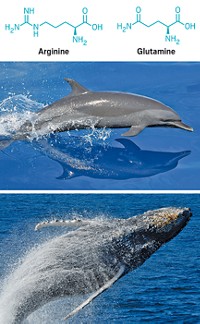Advertisement
Grab your lab coat. Let's get started
Welcome!
Welcome!
Create an account below to get 6 C&EN articles per month, receive newsletters and more - all free.
It seems this is your first time logging in online. Please enter the following information to continue.
As an ACS member you automatically get access to this site. All we need is few more details to create your reading experience.
Not you? Sign in with a different account.
Not you? Sign in with a different account.
ERROR 1
ERROR 1
ERROR 2
ERROR 2
ERROR 2
ERROR 2
ERROR 2
Password and Confirm password must match.
If you have an ACS member number, please enter it here so we can link this account to your membership. (optional)
ERROR 2
ACS values your privacy. By submitting your information, you are gaining access to C&EN and subscribing to our weekly newsletter. We use the information you provide to make your reading experience better, and we will never sell your data to third party members.
Environment
Methylmercury Alters Protein Expression In Rats’ Brains
Toxicology: Low doses of organic mercury seem to depress cellular metabolism in the somatosensory cortex of rat brains
by Naomi Lubick
August 27, 2013

People who eat fish regularly may ingest low doses of organic mercury, which are toxic metal contaminants found in aquatic environments. Toxicologists have long known that mercury compounds can trigger neurological problems and other conditions in fetuses and in children. But now they want to pinpoint how chronic exposure to low doses of these compounds, especially methylmercury, affects adults’ brains.
In a new study, researchers report that low doses of methylmercury seem to depress cellular metabolism in some parts of the brains of adult rats (J. Proteome Res. 2013, DOI: 10.1021/pr400356v).
In humans, one of the first symptoms of acute mercury poisoning is numbness or tingling of the skin. So the researchers, led by Samuel Chun-Lap Lo of Hong Kong Polytechnic University, decided to focus their study on the somatosensory cortex, the part of the brain that processes the sense of touch.
The team fed rats daily doses of methylmercury in corn oil over a number of weeks. The dose of 40 μg per kg of body weight was comparable to what a 70-kg person might get through regularly eating fish, but low enough not to trigger acute mercury poisoning in the rats (Neurotoxicol. Teratol. 2005, DOI: 10.1016/j.ntt.2005.03.011). As controls, the team also fed one group of rats corn oil without methylmercury and gave another group of rats neither corn oil or the metal compound. After four, eight and 12 weeks, Lo’s team used a suite of analytical techniques to measure the animals’ total mercury levels, concentrations of methylmercury, and protein expression levels in their brains. They compared data from the methylmercury-exposed rats to the two control groups.
In exposed rats, the somatosensory cortex had the highest concentrations of methylmercury compared to other parts of the brain. The researchers next looked at expression levels for 973 proteins in the cortex. They found that 104 of those proteins had significantly higher or lower expression levels in exposed rats compared to in control animals. In particular, 94 had decreased activity. The team also found lower concentrations of pyruvate, adenosine triphosphate, and calcium ions, all of which are integral to energy production in cells. Their levels could be lower because of the downregulated proteins, the researchers say.
While the experiments might mimic chronic methylmercury exposure in humans, Lo emphasizes that the metabolic effects don’t necessarily translate to humans. He says his team wants to look next at the visual cortex, to see protein behavior there in more detail. Researchers have been looking for reasons to explain a correlation between sight degeneration and methylmercury from fish consumption over a lifetime.
Chris K.C. Wong, a toxicologist at Hong Kong Baptist University, calls the proteomic approach used in the study “powerful.” Past research has shown that high doses of mercury affect pyruvate, ATP, and calcium ions, so it’s not a surprise to see that methylmercury at low doses also affects these energy metabolites, he says. Wong thinks the team next should determine whether the changes in protein expression are related to any neurological or behavioral changes in the animals.





Join the conversation
Contact the reporter
Submit a Letter to the Editor for publication
Engage with us on Twitter